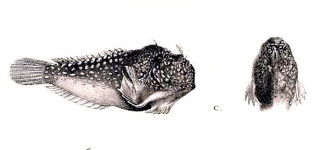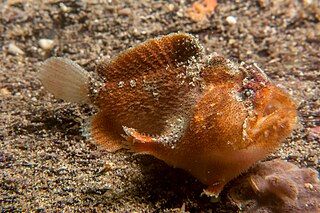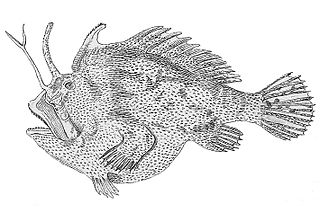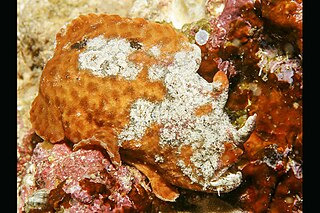
Frogfishes are any member of the anglerfish family Antennariidae, of the order Lophiiformes. Antennariids are known as anglerfish in Australia, where the term "frogfish" refers to members of the unrelated family Batrachoididae. Frogfishes are found in almost all tropical and subtropical oceans and seas around the world, the primary exception being the Mediterranean Sea.

The sargassum fish, anglerfish, or frog fish is a species of marine ray-finned fish belonging to the family Antennariidae, the frogfishes, the only species in the genus Histrio. It lives among Sargassum seaweed which floats in subtropical oceans. The scientific name comes from the Latin histrio meaning a stage player or actor and refers to the fish's feeding behaviour.

Glauert's anglerfish is species of marine ray-finned fish belonging to the subfamily Histiophryninae in the family Antennariidae, the frogfishes. This species is the only species in the monospecific genus Allenichthys. This species is endemic to southern Australia.

Tetrabrachiidae, or the four-armed frogfishes or doublefin frogfishes, is a small family of marine ray-finned fishes belonging to the suborder Antennarioidei in the order Lophiiformes, the anglerfishes. These fishes are found in relatively shallow waters of the eastern Indian Ocean and western Pacific Ocean.

Histiophryne is a genus of marine ray-finned fishes belonging to the subfamily Histiophryninae in the family Antennariidae, the frogfishes. These fishes are found in waters ranging from Taiwan to South Australia. There are currently five known species. These fishes are easily distinguished from other anglerfishes as having a reduced luring appendage, a highly evolved form of the first dorsal fin spine.
Butler's frogfish, Butler's anglerfish or the blackspot anglerfish, is a rare species of marine ray-finned fish belonging to the subfamily Histiophryninae the family Antennariidae, the frogfishes. The only member of its genus, this species is the most derived member of its family and represents a separate lineage from all other frogfishes, leading to some consideration of it being placed in its own family, the Tathicarpidae, this name being proposed by Pamela B. Hart et al in 2022. It is found off the southern coast of New Guinea, and along the coasts of Western Australia to 33° S latitude, the Northern Territory, and Queensland to 22° S latitude. A benthic species, it inhabits inshore tropical waters and coral reefs to a maximum depth of 145 m (476 ft), though most are found shallower than 45 m (148 ft). Its specific epithet honours its discoverer Dr. A. Graham Butler.

Antennarius is a genus of anglerfish belonging to the family Antennariidae, the frogfishes. The fishes in this genus are found in warmer parts of the Atlantic, Indian and Pacific Oceans.

Antennatus is a genus of marine ray-finned fishes belonging to the family Antennariidae, the frogfishes. The fishes in this genus are found the Indian and Pacific Oceans.

Echinophryne is a genus of marine ray-finned fishes belonging to the subfamily Histiophryninae in the family Antennariidae, the frogfishes. The fishes in this genus are endemic to the waters off Australia.

Fowlerichthys is a genus of marine ray-finned fishes belonging to the family Antennariidae, the frogfishes. The fishes in this genus are found the Atlantic, Indian and Pacific Oceans.

Kuiterichthys is a genus of marine ray-finned fishes belonging to the subfamily Histiophryninae in the family Antennariidae, the frogfishes. These fishes are endemic to Australia.

Lophiocharon is a genus of marine ray-finned fishes belonging to the subfamily Histiophryninae in the family Antennariidae, the frogfishes. These fishes are found in the eastern Indian Ocean and Western Pacific Ocean.

Nudiantennarius is a monospecific genus of marine ray-finned fish belonging to the family Antennariidae, the frogfishes. The only species in the genus is Nudiantennarius subteres, the deepwater frogfish. This fish is found in the Western Pacific Ocean.

Phyllophryne is a monospecific genus of marine ray-finned fish belonging to the subfamily Histiophryninae in the family Antennariidae, the frogfishes. The only species in the genus is Phyllophryne scortea, the white-spotted anglerfish, smooth anglerfish or smooth frogfish, which is endemic to southern Australia.

Rhycherus is a genus of marine ray-finned fishes belonging to the subfamily Histiophryninae in the family Antennariidae, the frogfishes. The fishes in this genus are endemic to the waters off Australia. This genus is classified in the monogeneric family Rhycheridae, the Balrog frogfishes, by some authorities.
Porophryne is a monospecific genus of marine ray-finned fish belonging to the subfamily Histiophryninae in the family Antennariidae, the frogfishes. The only species in the genus is Porophryne erythrodactylus, the red-fingered anglerfish, red-footed frogfish, Bare Island anglerfish or Sydney anglerfish, which is endemism to the waters off New South Wales in eastern Australia. Both the species and the genus were first described in 2014.

Echinophryne crassispina, the prickly anglerfish, prickly frogfish or thick-spined anglerfish, is a species of marine ray-finned fish belonging to the subfamily Histiophryninae in the family Antennariidae, the frogfishes. These fishes are endemic to the temperate waters of southern Australia.

Echinophryne mitchellii, the long-spined frogfish, bristly frogfish, Mitchell's anglerfish, Mitchell's frogfish, prickly angler fish or spinycoat anglerfish, is a species of marine ray-finned fish belonging to the subfamily Histiophryninae in the family Antennariidae, the frogfishes. These fishes are endemic to the temperate waters of southern Australia.

Lophiocharon trisignatus, the spot-tail anglerfish, rough anglerfish or three-spot frogfish, is a species of marine ray-finned fish belonging to the subfamily Histiophryninae in the family Antennariidae, the frogfishes. This fish is found in the Indo-Pacific region.

Abantennarius is a genus of marine ray-finned fishes belonging to the family Antennariidae, the frogfishes. The fishes in the genus are found in the Indian, Pacific and, one species, in the Western Atlantic Oceans.

















